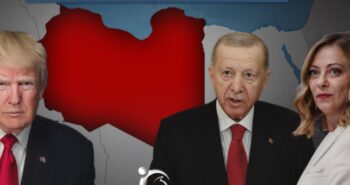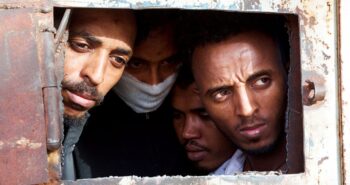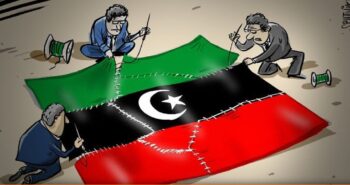Wolfram Lacher & Jérôme Tubiana

The EU’s push to curb Mediterranean crossings didn’t create Libya’s extortion economy, but has supercharged it, making migrants pawns in a lucrative game between the country’s rival governments.
Jackson left Cameroon in 2020, when he was 16 or 17. He spent two years in Libya and tried to cross the Mediterranean four times. On the last attempt, he was rescued by a European vessel, which took him to Italy. The previous times, he had been intercepted by the Libyan coastguard (LCG), backed by the European Union, and ended up spending months in Libyan detention centres. His struggling family in Cameroon had borrowed and wired several thousand euros for his crossing attempts and to buy his release from successive prisons.
His worst experience came after his second attempt in mid-2021, when his wooden craft was intercepted by a grey speedboat with an armed and masked crew. He and his fellow passengers were transferred not to an ‘official’ detention centre but to a series of underground pens which had apparently been used for livestock and now served to house the overflow of migrants. After two weeks, they were moved to a derelict pharmaceutical factory, which came to be known as Al-Maya detention centre.
Jackson said, ‘The place was abandoned. They opened up a large room covered in dust. We tried to clean it with our spare clothes and slept on the floor. There were more than 1,000 of us in that room. We were their first detainees; they had collected us to open Al-Maya.’ Some of this first group ended up building its future cells.
The one in which Jackson spent six months was almost hermetically sealed. Water in jerrycans and little food (a loaf or half a loaf each per day) were lowered on a rope from the roof. This was also the only way to get out. A video on social media shows a prisoner being pulled out — a rare event. Jackson mentioned a sick detainee being evacuated that way; he heard he had died shortly after. Some died from hunger, others from the winter cold.
The rope could also be used to pull out someone who had bought his release, though Jackson didn’t see this during his time there. In some Libyan detention centres, migrants are allowed to phone contacts to ask them to transfer money. Jackson and his cellmates tried to approach one of the more open-looking commanders. ‘Boss, please, what do you want from us? If it’s money, bring us a phone.’ The answer: ‘This place isn’t like other prisons. We don’t need your miserable money. We’re after the European Union. You can’t give us the sort of ransom the EU can. When we get what we’re looking for, we’ll release you’.
Not the usual sort of prison
Migrants who were detained in Al-Maya told of their surprise (and despair) when they understood that it wasn’t the usual sort of jail where they could buy their freedom. Up to 5,000 detainees were rounded up there to attract the attention of EU and UN agencies. The aim was to obtain the official recognition, equipment and funding already provided to other bodies focused on arresting migrants — the LCG and the interior ministry’s Department for Combating Illegal Migration (DCIM), which runs detention centres — by the internationally recognised government in Tripoli, as well as Italy and the EU and UN.
Those behind the Al-Maya scheme were well aware of the system. They included the Buzriba brothers from the neighbouring city of Zawiya, the godfathers of the local coastguard unit and Al-Nasr detention centre. This centre had been officially recognised by the Tripoli authorities, and visited by UN agencies, with the IOM (International Organisation for Migration) proposing the detainees’ ‘voluntary humanitarian return’ to their countries of origin. (The term ‘voluntary’ is questionable, particularly for people who have no money to buy their freedom.)
But the poor treatment of arrested migrants in Zawiya had led to Al-Nasr being delisted as an official detention centre and three of its top officials being sanctioned by the UN. The most notorious, Zawiya’s LCG unit commander Abderrahman Milad (‘Al-Bija’), was held by the Tripoli prosecutor for six months (he was later murdered in 2024). A key aim of the Al-Maya plan was to distance the new prison from these controversial figures and obtain official support.
In early 2021 the Buzribas joined the new Stability Support Apparatus (SSA) established by the Presidency Council in Tripoli, and Hassan Buzriba became its deputy chief. Largely autonomous from Tripoli, the Buzribas mended relations with former enemies in neighbouring Warshafana, and they decided to work together in Al-Maya, at the border between the two districts. They also built a port near the new detention site for patrol boats which they bought abroad, and began intercepting migrants at sea.
Yet the links with Zawiya’s controversial players remained visible. Many of Al-Maya’s detainees appear to have been arrested by Zawiya’s LCG and first held in Al-Nasr. This happened to Jackson when he attempted his third crossing, four months after his release from Al-Maya.
In Al-Nasr, the detainees were given only a few days to pay a 3,000 Libyan dinars (about $550) ransom, failing which they would end up in Al-Maya. The thought of returning there scared Jackson: ‘Relatives in Cameroon and friends in Europe paid and I was released after ten days. The next day, all the others were transferred.’ Al-Nasr had become a buffer to extort migrants’ money, and Al-Maya a dead-end prison to capture international funds.
Machiavellian and naïve
The scheme was both Machiavellian and naïve. For months following Al-Maya’s opening, the question of whether or not to visit it was hotly debated by international players involved with Libya. The EU and UN worried about reports of violence and officially avoided going there. But witnesses mentioned visits by people in IOM jackets, proposing the usual ‘voluntary’ returns. A Somalian minor, detained for six months just after Jackson, saw two IOM visits, which both went awry, turning into collective escape attempts, followed by deadly shootings.
With such a record, the scheme was unlikely to be successful. Further, the Buzribas’ relations with Tripoli soured in 2022 after they backed an unsuccessful attempt by a rival government to take over. In May 2023 government drones bombed Al-Maya’s fleet. Hopes of government and EU support faded. And gradually, the prison seemed to slide into a classic extortion model.
In fact, it wasn’t irrational for the Buzribas to gamble on obtaining European support if they could prevent a large enough number of migrants from taking to the sea, even if this involved abuses. The EU, including Italy, has relied on groups resorting to these same practices in their attempts to shut down migration via Libya.
EU migration policies have increasingly focused on controlling borders outside Europe. Commonly known as externalisation policies, they involve paying non-European states to block migrant flows, at sea and on land, as far south as possible. Yet among the 15 or so states with which the EU made agreements in recent years, Libya is unique in lacking a central authority: the government with which Italy signed its first deal in 2017 did not even control Tripoli. Currently, most of the country, including its eastern and southern borders, is controlled by the forces of Khalifa Haftar, who maintains a parallel government as a civilian façade for his military power.
Overall, the EU appears satisfied with the results of externalisation, and has repeatedly stated it intends to continue engaging with external ‘partners’. Considering the unique challenges it faced in Libya, the EU’s policies could be seen as successful in numerical terms, at least initially. Deals with Tripoli and Niger had an immediate impact on arrivals from Libya in Europe, dropping from a 165,000 peak in 2016 to 7,000 in 2019. But thereafter, arrivals from Libya again increased, reaching 47,000 in 2024.
Dubious and partial success
Seen in a broader context, even this partial success appears dubious. In 2023 some 157,000 migrants arrived in Italy, a figure nearing its earlier peak in 2016, explained by a shift in migration attempts from Libya to Tunisia. Flows continuously move from one route to another — as Libya closed down, Tunisia temporarily became a key transit country.
And the risky Atlantic crossing to the Canary Islands gained in importance when Libya, Tunisia and Morocco clamped down on departures. The nationalities currently dominating the Libyan route (Bangladeshis, Pakistanis, Syrians, Egyptians) partly reflect the fact that the Turkey-Balkans route has become tougher.
Such changes in routes have been yet another justification for the EU to continue its policies unabated and complete its North African blockade. In 2023 it quickly concluded a deal with Tunisia amid massive violence against sub-Saharan migrants, which pushed more of them to take to the sea. Tunisia then deported 13,000 migrants to the Libyan border, many ending locked in yet another new detention centre known as Al-Assa. Yet, oddly, the EU called its Tunisia deal a ‘blueprint’.
Since 2023 Brussels has also engaged in hasty partnerships with Egypt, Mauritania and Morocco — involving a softer stance with the latter on Western Sahara, from where boats also depart.
The EU’s focus on numbers has eclipsed the human cost of externalisation, beginning with mortality. Nearly 28,000 deaths have been recorded over the last decade in the Mediterranean, of which over 21,000 in the central Mediterranean. Crucially, while the rate of interceptions by the Libyan coastguard rose sharply from 12% to 50% of attempted crossings in the key 2017-19 years, the death rate at sea more than tripled, from 2% to 7%.
This contradicts the EU’s claim that its policies are saving lives. The EU’s naval operation Irini — unlike its predecessors — was established in 2020 without a mandate for sea rescue. Italy has taken to obstructing rescue ships operated by NGOs, and Germany has recently halted funding to them. All this raises the risk of death, and appears to be a deliberate strategy to maximise deterrence.
Less visibly, the desert hinterland south of Africa’s northern coast has been deadly too. In Niger, migrant deaths multiplied by five between 2016 and 2017 after an EU-backed law criminalising the transport of migrants was enforced. In Libya itself, data is lacking on deaths in the desert, in traffickers’ hangars where migrants are systematically tortured for ransom, and in official detention centres. Mass graves of migrants are occasionally discovered — but more such graves are likely filled daily.
***
Wolfram Lacher is a senior associate at the German Institute for International and Security Affairs in Berlin; Jérôme Tubiana is an advisor on refugee and migration issues for Médecins Sans Frontières.
_______________





